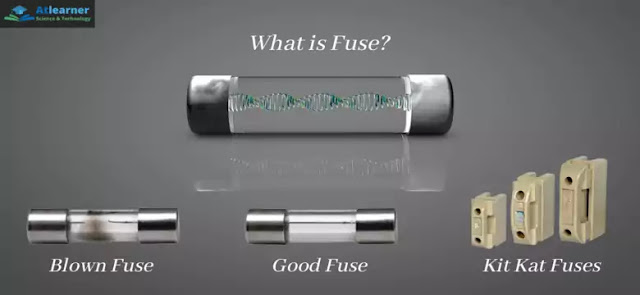What Is Fuse?
Definition: A fuse is an electrical safety device used to protect household appliances such as televisions, refrigerators, computers from unusually high currents due to overloading or short circuit.
Basically, fuses are sacrificial devices that are used only to protect various appliances connected throughout the circuit line.
Fuses come in many shapes and sizes and each fuse is designed to protect a circuit with specific electrical parameters (like the operating voltage, operating current, fuse element melting time, etc).
What Is The Principle Of Fuse?
An electric fuse operates based on the principle of the heating effect of electric current. Basically, the wires used in fuses have the characteristics of high resistance and low melting point.
These are the key features of a fuse wire that give a fuse the ability to protect electrical circuits or the equipment connected to the circuit.
Whenever a large amount of current or an excessive current flows in an electrical circuit, due to the high resistance of the fuse wire it gets heated and for the low melting point, it melts immediately and opens the circuit that disconnects the circuit from the power line.
What Are The Types Of Fuses?
Depending on the placement in the electrical circuit, the fuse is divided into two parts - AC fuse and DC fuse, later these are further divided into different categories. Below is a flowchart that shows different categories of fuses.
However, in this article, we will only discuss the Cartridge Fuse and Rewireable/Kit-Kat Fuse. Later we will go into the details about these different types of fuse in another article.
Cartridge Fuse:
Cartridge types fuses are totally closed cylindrical-shaped containers like fuses that have metal caps for contact at both ends. The metal contact points are connected by a length of material meant to melt or sacrifice itself, for the unusually high currents due to overloading or short circuit.
These types of fuses are used to protect electrical appliances such as motors, air conditions, refrigerators, pumps, etc, where high voltage ratings and currents are required.
There are two types of Cartridge Fuses - D-Type Cartridge Fuses and Link Type Or HRC(High Rupturing Capacity) Fuses. Know more....
Rewireable/Kit-Kat Fuse:
Kit Kat Fuses are semi-enclosed fuses, that are also known as rewireable fuses. This is because the wires used in this fuse can be replaced if it gets burnt due to the excessive flow of electric current.
These types of fuses are mainly designed for household wiring purposes where very low currents are to be handled. There are two parts in kit kat fuses – fuse wire and fuse base.
The main benefits of using the KitKat fuses are - they very easy and quick to install, they are cheaper and they don'ts require maintenance throughout their serving life.
Can Any Wire Be Used As A Fuse Wire, If Not Why?
No, we cannot use any wire as a fuse wire because there have certain characteristics features for using a wire as a fuse wire, such as the wire must have a low melting point and high resistance.
For example, we cannot use copper wire as a fuse wire because copper has a high melting point and low resistance. But an alloy of lead and tin can be used as a fuse wire because it has a low melting point and a very high resistance.
What Is The Rating Of Fuse Wire Used In The Domestic Circuits?
If a fuse is rated as 10 amperes, it will pass 10 amperes current through it, not more. A current above 10 amperes will melt the fuse, which will "blow" and break the circuit.
In a household circuit system, two types of circuits are used. One with a 15 amperes rating for appliances with high power rating and another with 5 amperes rating for bulbs etc.
So in the household circuit, the used fuse also has that rating. For the 15 amperes rating, a thick wire is used and for the 5 amperes rating, a thinner wire is used.
Why A Fuse Is Always Connected To The Live Wire And Not To The Neutral Wire?
If the fuse is kept in the neutral wire, then due to the excessive current flow when the fuse burns, the current stops flowing in the circuit, but the device is still connected to the high potential power supply via the live wire.
Now if a person touches the device, he may get a shock because the person will come in contact with the live wire through the device. That is why a fuse is always connected to the live wire and not to the neutral wire.
Why A Fuse Is Always Connected In Series And Not In Parallel?
Fuses are always connected in series in the circuit to protect the equipment from the excessive flow of electric current. If we connect the fuse in parallel with the circuit, there will be no use of the fuse.
However, if we connect the fuse in parallel with the circuit, the current will continue to flow throughout the circuit even if the fuse burns out. So the fuse is always connected in series so that in case of overload or short circuit it will open or disconnect the circuit.
Use of Miniature Circuit Breaker (MCB) in place of Fuse
In the case of a fuse, it is necessary to open the fuse grip and inspect the entire fuse wire to confirm the fault area. But if we use MCB instead of Fuses then It can detect any abnormality in the current flow and automatically shuts off the electrical circuit.
So in many cases using MCB is more profitable than the fuse.
Continue Reading...




